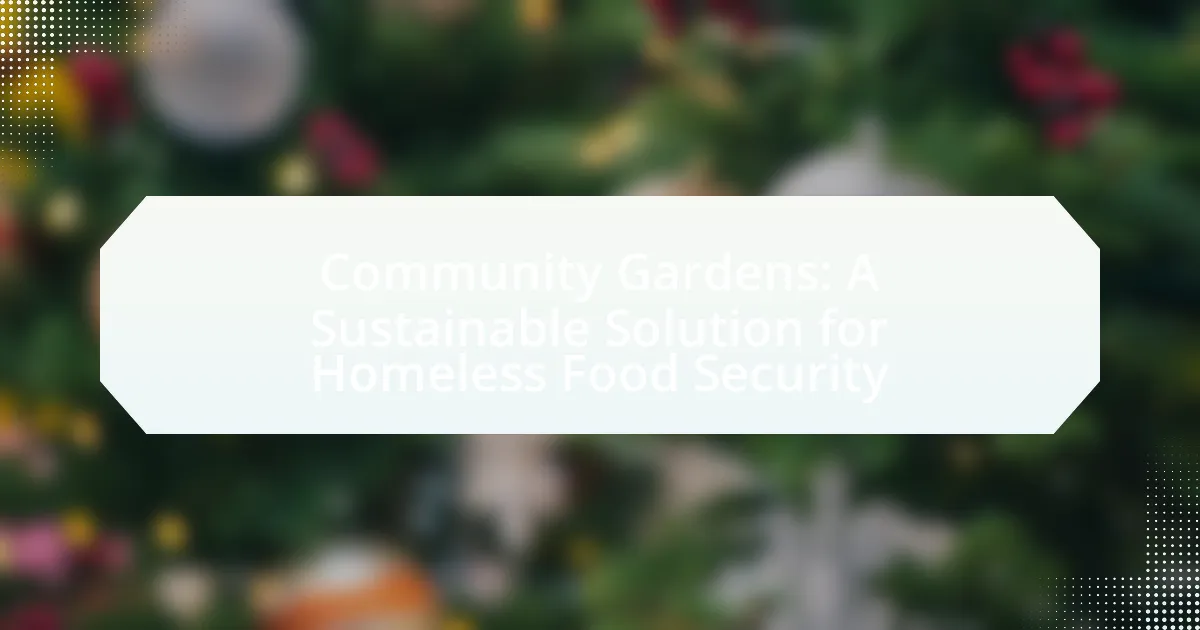Community gardens are shared plots of land where individuals or groups cultivate plants, primarily for food production, with the aim of promoting sustainable agriculture and enhancing community engagement. They play a crucial role in improving food security, particularly for homeless populations, by providing access to fresh produce and fostering social connections. The article explores how community gardens contribute to self-sufficiency, address specific needs of vulnerable groups, and offer environmental benefits. It also discusses the challenges these gardens face, such as funding and zoning regulations, and highlights strategies for effective implementation and community involvement. Additionally, the article examines the long-term impacts of community gardens on food security and emerging trends in urban agriculture.

What are Community Gardens and Their Purpose?
Community gardens are shared plots of land where individuals or groups cultivate plants, primarily for food production. Their purpose is to promote sustainable agriculture, enhance community engagement, and provide access to fresh produce, particularly in urban areas where food deserts exist. Research indicates that community gardens can improve food security by increasing the availability of nutritious food options, fostering social connections, and encouraging environmental stewardship. For example, a study published in the Journal of Community Health found that participation in community gardening significantly increased fruit and vegetable consumption among participants, demonstrating their effectiveness in addressing food insecurity.
How do Community Gardens contribute to food security?
Community gardens contribute to food security by providing local access to fresh produce, which enhances the availability of nutritious food options for communities. These gardens enable individuals and families to grow their own fruits and vegetables, reducing reliance on commercial food sources that may be expensive or inaccessible. Research indicates that community gardens can increase food production in urban areas, with studies showing that they can yield up to 1,000 pounds of produce per year on a single plot. Additionally, community gardens foster social cohesion and empower residents, leading to increased community engagement and collaboration in addressing food-related challenges.
What specific needs do Community Gardens address for the homeless population?
Community gardens address the specific needs of the homeless population by providing access to fresh food, fostering social connections, and offering a sense of community. These gardens enable individuals experiencing homelessness to grow their own fruits and vegetables, which directly contributes to improved nutrition and food security. Research indicates that community gardens can increase access to healthy food options, as they often serve areas with limited grocery stores. Additionally, participation in gardening activities promotes social interaction and community engagement, which can enhance mental well-being and reduce feelings of isolation among homeless individuals. Studies have shown that community gardens can lead to increased self-esteem and empowerment, as individuals take part in the cultivation process and contribute to their local environment.
How do Community Gardens promote self-sufficiency among participants?
Community gardens promote self-sufficiency among participants by providing access to fresh produce and fostering skills in gardening and food production. Participants learn to cultivate their own food, which reduces reliance on external food sources and enhances food security. Research indicates that community gardens can increase participants’ knowledge of nutrition and sustainable practices, leading to healthier eating habits and improved well-being. Additionally, these gardens often create a sense of community, encouraging collaboration and resource sharing, which further supports self-sufficiency.
Why are Community Gardens considered a sustainable solution?
Community gardens are considered a sustainable solution because they promote local food production, enhance biodiversity, and foster community engagement. By growing food locally, these gardens reduce the carbon footprint associated with transporting food over long distances. Additionally, they create habitats for various species, contributing to ecological balance. Studies have shown that community gardens can increase access to fresh produce, which is crucial for food security, particularly in urban areas where access to healthy food options is limited. Furthermore, they encourage social interaction and cooperation among community members, strengthening social ties and resilience.
What environmental benefits do Community Gardens provide?
Community gardens provide significant environmental benefits, including enhanced biodiversity, improved air quality, and effective stormwater management. These gardens create habitats for various species, promoting ecological diversity; for instance, studies show that urban gardens can support over 50 different species of birds and numerous pollinators. Additionally, the plants in community gardens absorb carbon dioxide and release oxygen, contributing to better air quality. Furthermore, community gardens help manage stormwater by reducing runoff and promoting groundwater recharge, which is crucial in urban areas prone to flooding. Research indicates that green spaces can reduce surface temperatures by up to 5 degrees Fahrenheit, mitigating the urban heat island effect.
How do Community Gardens foster community engagement and support?
Community gardens foster community engagement and support by providing a shared space for individuals to collaborate on gardening projects, thereby enhancing social interactions and building relationships. These gardens serve as a platform for community members to participate in collective activities, such as planting, maintaining, and harvesting crops, which promotes teamwork and a sense of belonging. Research indicates that community gardens can increase social cohesion, as evidenced by a study published in the Journal of Community Psychology, which found that participants reported improved social ties and community involvement after engaging in gardening activities. Additionally, community gardens often host events and workshops that educate residents about sustainable practices, further strengthening community bonds and support networks.

What Challenges do Community Gardens Face?
Community gardens face several challenges, including land access, funding, and community engagement. Limited access to suitable land often hinders the establishment and sustainability of these gardens, as many urban areas have high real estate costs and zoning restrictions. Additionally, securing funding for resources such as seeds, tools, and maintenance can be difficult, as community gardens often rely on grants or donations that may not be consistently available. Furthermore, maintaining active community engagement is crucial; without consistent participation from local residents, gardens can become neglected and fail to thrive. These challenges are documented in studies highlighting the importance of community involvement and financial support for the success of urban agriculture initiatives.
How do funding and resource limitations impact Community Gardens?
Funding and resource limitations significantly hinder the development and sustainability of community gardens. These limitations restrict access to essential materials such as seeds, soil, tools, and infrastructure, which are crucial for successful gardening. For instance, a study by the American Community Gardening Association found that gardens with inadequate funding often struggle to maintain their plots, leading to decreased productivity and community engagement. Additionally, limited financial resources can prevent gardens from implementing educational programs or outreach initiatives, which are vital for fostering community involvement and awareness about food security issues.
What strategies can be implemented to overcome these challenges?
To overcome challenges in community gardens aimed at addressing homeless food security, implementing collaborative partnerships is essential. These partnerships can involve local governments, non-profits, and community organizations to secure funding, resources, and expertise. For instance, a study by the American Community Gardening Association highlights that community gardens with strong partnerships are more successful in sustaining operations and expanding their reach. Additionally, providing education and training programs for participants can enhance gardening skills and improve food production, as evidenced by research from the University of California, which found that training increased yields by up to 30%. Lastly, establishing a clear governance structure within the garden can help in decision-making and conflict resolution, ensuring that all voices are heard and that the garden meets the needs of the community effectively.
How do zoning laws and regulations affect the establishment of Community Gardens?
Zoning laws and regulations significantly influence the establishment of community gardens by determining land use, permissible activities, and the legal framework for garden operations. These laws can either facilitate or hinder the creation of community gardens based on factors such as zoning classifications, which dictate whether land can be used for agricultural purposes, and any restrictions on the types of structures or activities allowed within those zones. For instance, in urban areas where land is primarily zoned for residential or commercial use, community gardens may face challenges in obtaining the necessary permits or may be outright prohibited. Additionally, regulations regarding property maintenance, water usage, and pesticide application can impose further limitations on how community gardens are managed. Research indicates that cities with supportive zoning policies, such as those that explicitly allow community gardens in their zoning codes, tend to have higher rates of successful garden establishment and sustainability.
What role do volunteers play in the success of Community Gardens?
Volunteers are essential to the success of community gardens as they provide the labor, skills, and community engagement necessary for effective garden management. Their involvement directly contributes to the cultivation, maintenance, and harvesting of crops, which enhances food production and sustainability. Research indicates that community gardens with active volunteer participation yield higher crop outputs and foster stronger community ties, leading to improved food security for vulnerable populations. For instance, a study published in the Journal of Community Gardening found that gardens with regular volunteer involvement increased their harvest by 30% compared to those with minimal volunteer engagement. This demonstrates that volunteers not only support the physical aspects of gardening but also play a crucial role in building a sense of community and shared responsibility, which is vital for the long-term success of these initiatives.
How can volunteer engagement be increased in Community Gardens?
Volunteer engagement in Community Gardens can be increased by implementing structured outreach programs and creating a welcoming environment. Research indicates that community involvement is significantly enhanced when gardens host regular events, workshops, and social gatherings, which foster a sense of belonging and purpose among volunteers. For instance, a study published in the Journal of Community Gardening found that gardens with consistent volunteer recognition and appreciation events saw a 40% increase in volunteer retention rates. Additionally, providing clear roles and responsibilities for volunteers can enhance their commitment and satisfaction, as evidenced by surveys indicating that volunteers prefer defined tasks that align with their skills and interests.
What skills can volunteers gain from participating in Community Gardens?
Volunteers can gain various skills from participating in Community Gardens, including gardening techniques, teamwork, and community engagement. Gardening techniques encompass planting, maintaining, and harvesting crops, which enhance horticultural knowledge and practical skills. Teamwork is developed through collaboration with other volunteers, fostering communication and interpersonal skills. Community engagement skills are cultivated as volunteers interact with diverse groups, promoting social awareness and a sense of belonging. These skills contribute to personal development and can improve employability in related fields.

How can Community Gardens be Implemented Effectively?
Community gardens can be implemented effectively by fostering community involvement, securing land access, and providing education on sustainable gardening practices. Engaging local residents in the planning and maintenance of the garden ensures that the project meets their needs and builds a sense of ownership. Securing land access through partnerships with local governments or organizations is crucial, as it provides a stable location for the garden. Additionally, offering workshops on organic gardening, composting, and pest management equips participants with the necessary skills to maintain the garden sustainably. Research indicates that community gardens can increase food security and improve community cohesion, as demonstrated by a study published in the Journal of Community Health, which found that community gardens significantly enhance access to fresh produce in urban areas.
What best practices should be followed when starting a Community Garden?
To successfully start a Community Garden, it is essential to establish a clear plan that includes community involvement, site selection, and sustainable practices. Engaging local residents in the planning process fosters ownership and ensures the garden meets community needs. Selecting a suitable site involves assessing sunlight, soil quality, and access to water, which are critical for plant growth. Implementing sustainable practices, such as organic gardening methods and composting, enhances soil health and promotes biodiversity. Research indicates that community gardens can improve food security and foster social connections, making them a valuable resource for neighborhoods.
How can community members be involved in the planning process?
Community members can be involved in the planning process by participating in meetings, providing input on garden design, and volunteering for maintenance tasks. Engaging local residents fosters a sense of ownership and ensures that the gardens meet the specific needs of the community. Research indicates that community involvement in urban gardening projects leads to increased sustainability and better food security outcomes, as seen in studies conducted by the American Community Gardening Association, which highlight the positive impact of community engagement on project success.
What types of crops are best suited for Community Gardens aimed at food security?
Vegetables such as tomatoes, peppers, and leafy greens are best suited for community gardens aimed at food security. These crops are high-yielding, nutritious, and can be grown in limited space, making them ideal for urban gardening. For instance, tomatoes can produce up to 10 pounds per plant, providing substantial food resources. Leafy greens like spinach and kale grow quickly and can be harvested multiple times, ensuring a continuous food supply. Additionally, legumes such as beans and peas enrich the soil with nitrogen, promoting overall garden health and sustainability.
What resources are available for establishing Community Gardens?
Resources available for establishing Community Gardens include local government grants, nonprofit organizations, and community engagement initiatives. Local governments often provide funding and support through grants aimed at urban agriculture and community development. Nonprofit organizations, such as the American Community Gardening Association, offer resources, training, and networking opportunities for community gardeners. Additionally, community engagement initiatives can facilitate partnerships with local businesses and schools, enhancing resource availability and support for garden projects. These resources collectively contribute to the successful establishment and sustainability of Community Gardens, addressing food security issues effectively.
How can local governments support Community Garden initiatives?
Local governments can support Community Garden initiatives by providing land access, funding, and resources for development and maintenance. By designating public land for community gardens, local governments enable residents to cultivate food, which directly addresses food insecurity. Additionally, financial support through grants or subsidies can help cover costs for tools, seeds, and educational programs. Research indicates that community gardens can increase food access by 30% in urban areas, demonstrating their effectiveness in enhancing food security. Furthermore, local governments can facilitate partnerships with non-profits and community organizations to promote gardening education and outreach, ensuring sustainable practices and community engagement.
What organizations provide assistance and funding for Community Gardens?
Organizations that provide assistance and funding for community gardens include the American Community Gardening Association, which offers grants and resources for garden development, and the USDA Community Food Projects Competitive Grant Program, which funds projects aimed at increasing food security. Additionally, local non-profits such as the GreenThumb program in New York City support community gardens through technical assistance and funding opportunities. These organizations play a crucial role in promoting sustainable food practices and enhancing community resilience.
What are the long-term impacts of Community Gardens on food security for the homeless?
Community gardens significantly enhance food security for the homeless over the long term by providing consistent access to fresh produce and fostering community engagement. Research indicates that these gardens can increase food availability, improve nutritional intake, and reduce reliance on food banks. For instance, a study published in the Journal of Agriculture, Food Systems, and Community Development found that community gardens can lead to a 50% increase in fruit and vegetable consumption among participants, which directly benefits homeless individuals who often lack access to nutritious food. Additionally, community gardens promote social cohesion and empower individuals by involving them in the cultivation process, thereby improving their overall well-being and resilience against food insecurity.
How can success be measured in Community Garden projects?
Success in Community Garden projects can be measured through various quantitative and qualitative metrics, including the amount of produce harvested, community engagement levels, and improvements in local food security. For instance, a study by the American Community Gardening Association found that community gardens can yield an average of 500 pounds of produce per year, significantly contributing to food access for low-income families. Additionally, surveys assessing community involvement, such as participation rates in gardening activities and educational workshops, provide insight into the project’s social impact. Furthermore, tracking changes in food security indicators, such as the number of households reporting improved access to fresh fruits and vegetables, serves as a critical measure of success in addressing food insecurity within the community.
What future trends are emerging in the realm of Community Gardens and food security?
Future trends in community gardens and food security include increased integration of technology, such as apps for garden management and community engagement, and a focus on biodiversity to enhance resilience against climate change. Research indicates that urban agriculture initiatives, including community gardens, are projected to grow by 20% over the next decade, driven by rising food insecurity and urbanization. Additionally, there is a trend towards educational programs that teach sustainable practices and nutrition, which have been shown to improve food access and community health outcomes.
What practical steps can individuals take to support Community Gardens?
Individuals can support Community Gardens by volunteering their time for maintenance and planting activities. Engaging in regular gardening tasks helps ensure the gardens remain productive and vibrant. Additionally, individuals can donate resources such as seeds, tools, or compost, which are essential for the growth and sustainability of these gardens. Financial contributions can also be made to local community garden organizations, enabling them to purchase necessary supplies and expand their reach. Furthermore, individuals can advocate for community gardens by promoting their benefits within their neighborhoods, thereby increasing community involvement and awareness. Studies show that community gardens can improve food security and foster community cohesion, making these actions impactful.

Leave a Reply